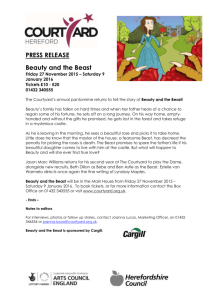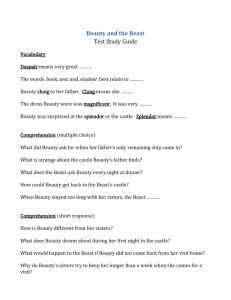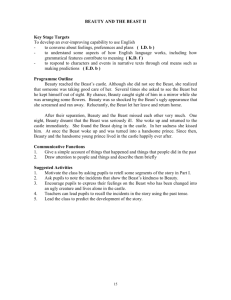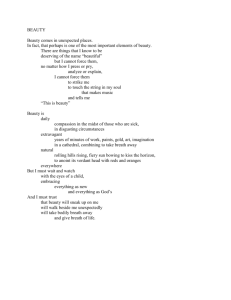6 Example Drama Evaluation Beauty and the Beast
advertisement
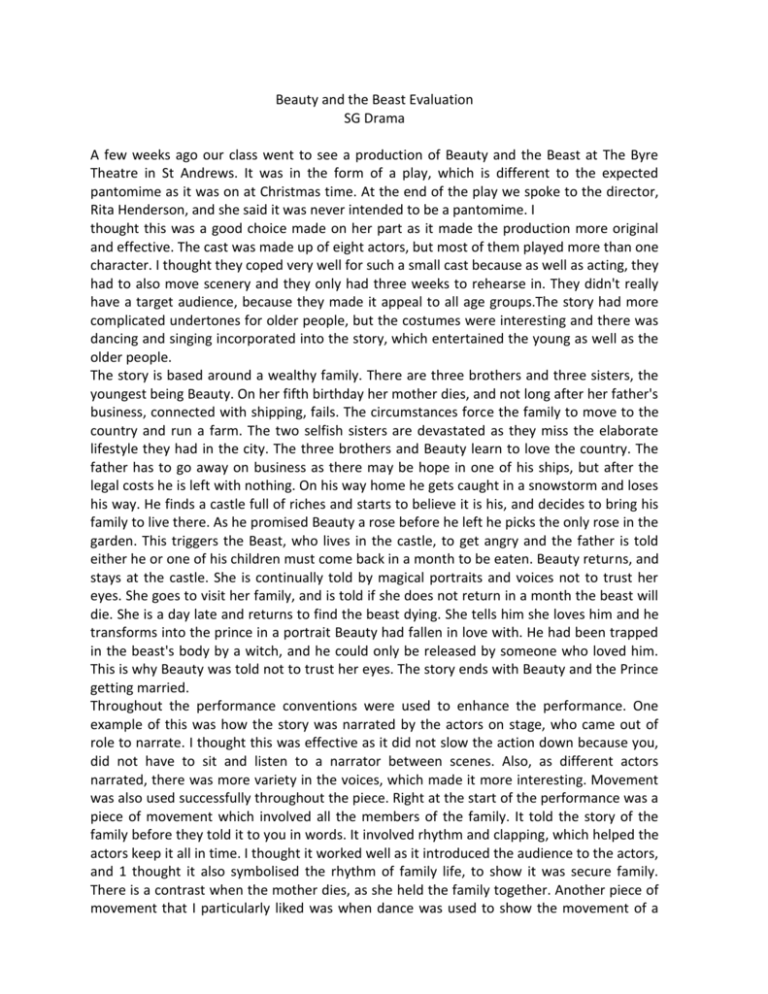
Beauty and the Beast Evaluation SG Drama A few weeks ago our class went to see a production of Beauty and the Beast at The Byre Theatre in St Andrews. It was in the form of a play, which is different to the expected pantomime as it was on at Christmas time. At the end of the play we spoke to the director, Rita Henderson, and she said it was never intended to be a pantomime. I thought this was a good choice made on her part as it made the production more original and effective. The cast was made up of eight actors, but most of them played more than one character. I thought they coped very well for such a small cast because as well as acting, they had to also move scenery and they only had three weeks to rehearse in. They didn't really have a target audience, because they made it appeal to all age groups.The story had more complicated undertones for older people, but the costumes were interesting and there was dancing and singing incorporated into the story, which entertained the young as well as the older people. The story is based around a wealthy family. There are three brothers and three sisters, the youngest being Beauty. On her fifth birthday her mother dies, and not long after her father's business, connected with shipping, fails. The circumstances force the family to move to the country and run a farm. The two selfish sisters are devastated as they miss the elaborate lifestyle they had in the city. The three brothers and Beauty learn to love the country. The father has to go away on business as there may be hope in one of his ships, but after the legal costs he is left with nothing. On his way home he gets caught in a snowstorm and loses his way. He finds a castle full of riches and starts to believe it is his, and decides to bring his family to live there. As he promised Beauty a rose before he left he picks the only rose in the garden. This triggers the Beast, who lives in the castle, to get angry and the father is told either he or one of his children must come back in a month to be eaten. Beauty returns, and stays at the castle. She is continually told by magical portraits and voices not to trust her eyes. She goes to visit her family, and is told if she does not return in a month the beast will die. She is a day late and returns to find the beast dying. She tells him she loves him and he transforms into the prince in a portrait Beauty had fallen in love with. He had been trapped in the beast's body by a witch, and he could only be released by someone who loved him. This is why Beauty was told not to trust her eyes. The story ends with Beauty and the Prince getting married. Throughout the performance conventions were used to enhance the performance. One example of this was how the story was narrated by the actors on stage, who came out of role to narrate. I thought this was effective as it did not slow the action down because you, did not have to sit and listen to a narrator between scenes. Also, as different actors narrated, there was more variety in the voices, which made it more interesting. Movement was also used successfully throughout the piece. Right at the start of the performance was a piece of movement which involved all the members of the family. It told the story of the family before they told it to you in words. It involved rhythm and clapping, which helped the actors keep it all in time. I thought it worked well as it introduced the audience to the actors, and 1 thought it also symbolised the rhythm of family life, to show it was secure family. There is a contrast when the mother dies, as she held the family together. Another piece of movement that I particularly liked was when dance was used to show the movement of a horse. As the actor who played the horse was a good dancer, and the director was a choreographer, the strength and grace of a horse was portrayed very well through the use of dance. Also, the actor had a mask of a horse's head on which hid their face; this meant we could not see the human features so it was a lot easier to believe he was a horse. There was a piece of movement when the actors formed a rose bush by placing themselves in a group, with people at the back standing taller than people at the front. They held paper leaves and there was a single rose in the heart of the 'bush'. The actors were in grotesque, twisting shapes, with their fingers splayed to represent thorns. They also had ugly expressions on their faces to show how vicious the thorns were. When the father tried to pick the rose, the bush would move and scratch him with the thorns. I thought this was very effective because it made the bush look alive, which implied that it was magical. It was also very visually interesting, with the bush twisting into different shapes. I thought the actress who played one of the sisters and the maid in Beast's castle performed very well. When she played one of the sisters, she had a very posh and snobby accent, and her register was that she was talking down to everyone, apart from her father, who she sucked up to when she wanted something. This expressed the way she saw herself and it also showed the conceitedness of that character. She had very good posture, and walked around with her nose in the air. Her dress had a big bustle at the back, and she had a very bouncy walk. She also swung her hips from side to side when she walked. When she strutted around like this it made the bustle bounce around, which was entertaining because she obviously thought she was superior to everyone else, but she just looked ridiculous. All her gestures were very big and over-the-top. Also, all of her facial expressions were very animated and exaggerated. One example of this was when she did not get her own way, she would make a big show of folding her arms, and she o wuld have a sulky pout and a big frown on her face. As she was so exaggerated and L-1 melodramatic, her character wasn't very realistically believable, but I thought this was good because it made her character seem a bit like a cartoon character. This was appropriate as Beauty and the Beast is a fairy tale, which is not real, therefore I think it is fine for the characters to be over-the-top, even if it is not realistic. As she was largerthen-life, it was more entertaining, especially for younger children. All of her movement and facial expressions portrayed the vanity, smugness and snobbishness of the character. The other character she played was the maid in the Beast's house. When she was this character, her speech was very stilted and wooden. She had a very elated tone, and she was nearly always happy. If she was sad, it would just be for a second, then she would be giggling infectiously again, and she seemed to giggle all the time. I thought this was done very well because every time the maid did giggle, it would sound realistic and fresh, like she really was very amused by something, which then amused the audience. I think this would be difficult to do because it is hard just to 'turn on' a laugh without it sounding, unrealistic. Her facial expressions were much exaggerated, but she had the same expression of a big, wide grin on her face. She managed to sustain this without letting the grin slip, and she did not corpse once. This was successful because it showed continuity in her character, and made it more believable. Her movement was also very stilted and mechanical, especially her gestures. Instead of walking, she spins with her arms straight out at shoulder height and her fingers pointing towards the ceiling, and she giggles and laughs all the time while spinning. At one point, she suddenly stops and flops over at the waist. A clown then mimes pulling at a string on her back, and she giggles and stands up straight, then flops again. He pulls the string again, and she giggles very loudly and spins away quickly. She did this bit very well, because she flopped over very jerkily, and when she came back up she had the same expression on her face. This made it look like she was not real and reinforced the idea of being mechanical. All these aspects help portray the puppet-like quality of her character, and hint to us that she may not be human, but a sort of doll. We later find out that this is true, and she is made out of wood, but was brought to life by a witch. Also, these aspects make the character more interesting to watch, and it was entertaining for the audience. 11 Theatre arts were used effectively throughout the performance. One example of this was the simple but versatile set. The set was made of a material called tivex (jay cloths are made from this). White tivex was stretched across tall metal frames, and there were cutouts of trees at the top, to represent a forest. There were also flaps in the shape of doors and windows cut into the tivex. As the tivex was so thin, and the fact that it was white, helped symbolize how pure but delicate love is, as love was a major theme in the story. I also thought it was a good material to use because if you shine light behind it, it is quite transparent, but if you shine a light on to the front of it, it isn't. This meant that they could either have a solid background, or they could create shadows. One example of the shadows being used was when Beauty and the maid are looking at all the different rooms. You can see the shadow of them skipping through the castle behind the screen. As the set is on wheels, it can be moved around to achieve different effects. It can be pushed forward, so the stage is very small and close to the audience, therefore the scene will have a more intimate feel. One scene that worked well was when the flats were moving while Beauty was running through the doors, which gave a feeling of space, and it represented Beauty running through all the rooms in the castle. The fact that the set was white meant that it was versatile. This meant that it would take on the colour of light that was shining on it. This was good as it meant various colours of light could be used to create atmosphere, and it also meant the set did not detract from the acting. The floor was high gloss and black, which contrasted well with the white set. This also fitted in with the luxurious setting of the palace. The window, the swing, the table, chandelier and the drapes were flown in from the flies, and they were also white. This fitted in with the plain white canvas of the set. It also tied in with the magical feeling of the castle, because it looked like things just appeared whole when you needed them. Another example of theatre arts was the good use of costume. Period costume was used, with the girls wearing skirts with bustles and the men had tights, wigs and long coats on. This worked well because at the start it made it obvious they were a wealthy family as the girls wore elaborate wigs and embroidered skirts, and the boys had fancy wigs and coats with tails. The girls then removed the wigs, and replaced them with maid's bonnets. They also removed the top layer of their skirts, which was embroidered, which left them with plain skirts. The men also removed their wigs, and they removed their coats with tails. They were left with a simple white shirt and pantaloons. This costume change took place on stage. I thought this was good as it saved time and did not stop the flow of the action and story. This costume change also symbolises the family slipping from wealth into poverty. The base costume was a blouse and petticoat or a shirt and pantaloons, all coloured white. I thought this was sensible as it meant they were adaptable because it tied in with the white set, and took on the colour of light. It also meant that you could put a coloured skirt on top of it to show it was one of the sisters, or you could put a black apron on top of it to show it was a maid. This meant the costume changes were quick. Also, the two sisters shoes were high-heeled white cabaret shoes, but Beauty's were flat white T-bar shoes. Beauty also had a less elaborate costume than the two sisters, and did not wear a wig. This helped set Beauty apart from the two sisters, and it showed she was more innocent and less selfish, materialistic and vain than they were. When Beauty was travelling either to or from the castle, she wore a red cape. This reinforced her connection with the rose, and when the witch was stabbed, it symbolised blood. The Beast's costume was a mask with dreadlocks, a big cloak, gloves and big black gothic boots with a metal heel and studs. All of his costume was coloured black, which contrasted sharply with Beauty's white dress, which reflected light. This symbolised the contrast between Beauty's innocence and naivety and the Beast's tainted life and his pain. His costume was quite modem, which helped appeal to the teenage audience. When the beast transforms into the prince, he takes off the costume on stage and reveals the Princes white costume. This tells us that the Prince is now happy and no longer in pain. Overall, I thought the set was designed well, and the cast was made up of talented actors. I particularly enjoyed the way a lot of dance was incorporated into the play, as it gave it a fresh perspective and helped to communicate with the audience. Lighting was used to good effect, as was costume and sound. The only improvement I could suggest is that Beauty should get married to the Beast when he is till a Beast, instead of getting married once he has turned into a prince. This would mean you knew she was getting married for the person inside, not just because he is a handsome prince, and this would also thoroughly continue the moral of the story, which is to trust your heart before your eyes. Overall, I thoroughly enjoyed this simple, original and effective production of Beauty and the Beast.
